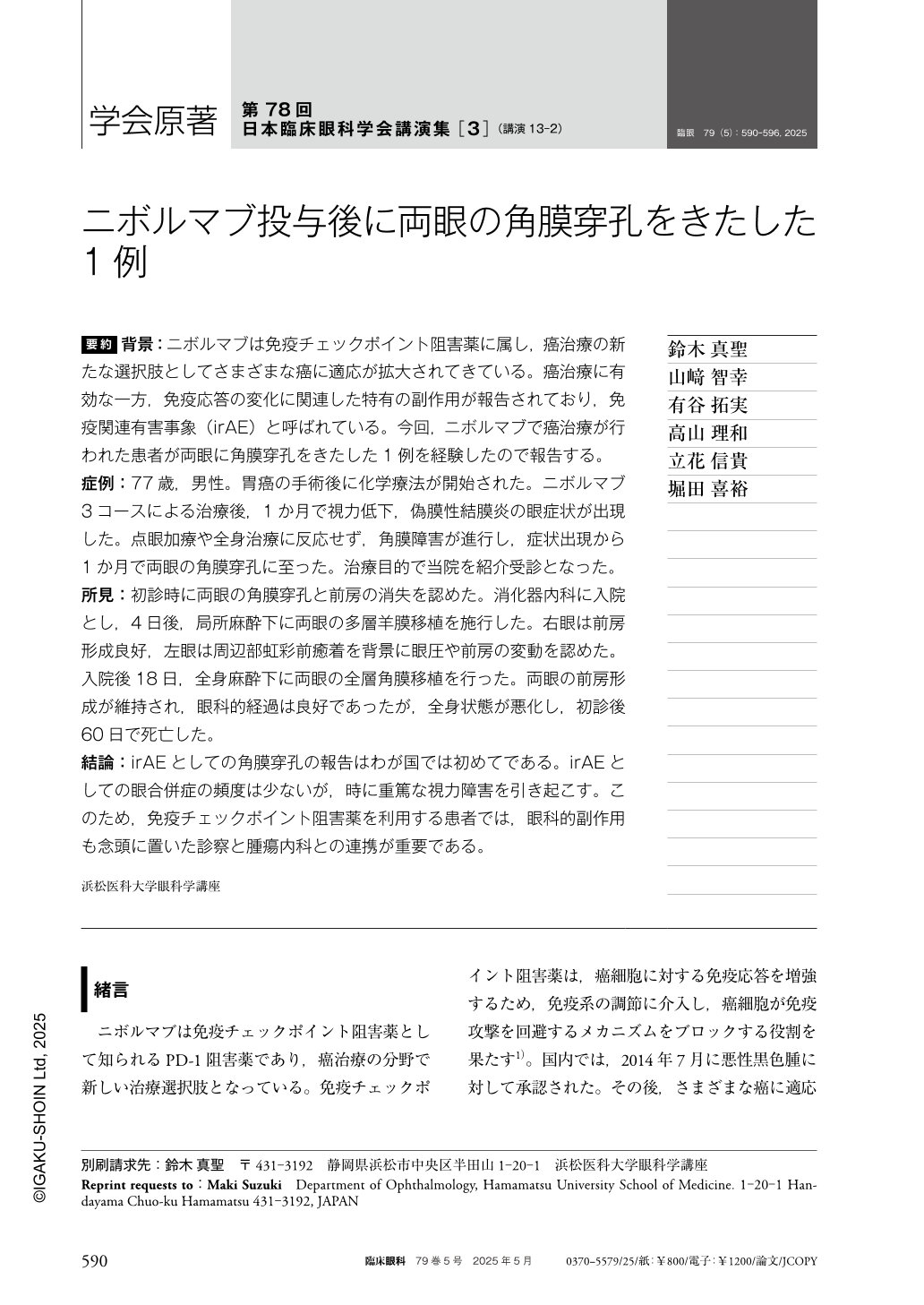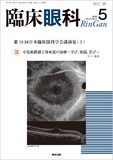Japanese
English
- 有料閲覧
- Abstract 文献概要
- 1ページ目 Look Inside
- 参考文献 Reference
要約 背景:ニボルマブは免疫チェックポイント阻害薬に属し,癌治療の新たな選択肢としてさまざまな癌に適応が拡大されてきている。癌治療に有効な一方,免疫応答の変化に関連した特有の副作用が報告されており,免疫関連有害事象(irAE)と呼ばれている。今回,ニボルマブで癌治療が行われた患者が両眼に角膜穿孔をきたした1例を経験したので報告する。
症例:77歳,男性。胃癌の手術後に化学療法が開始された。ニボルマブ3コースによる治療後,1か月で視力低下,偽膜性結膜炎の眼症状が出現した。点眼加療や全身治療に反応せず,角膜障害が進行し,症状出現から1か月で両眼の角膜穿孔に至った。治療目的で当院を紹介受診となった。
所見:初診時に両眼の角膜穿孔と前房の消失を認めた。消化器内科に入院とし,4日後,局所麻酔下に両眼の多層羊膜移植を施行した。右眼は前房形成良好,左眼は周辺部虹彩前癒着を背景に眼圧や前房の変動を認めた。入院後18日,全身麻酔下に両眼の全層角膜移植を行った。両眼の前房形成が維持され,眼科的経過は良好であったが,全身状態が悪化し,初診後60日で死亡した。
結論:irAEとしての角膜穿孔の報告はわが国では初めてである。irAEとしての眼合併症の頻度は少ないが,時に重篤な視力障害を引き起こす。このため,免疫チェックポイント阻害薬を利用する患者では,眼科的副作用も念頭に置いた診察と腫瘍内科との連携が重要である。
Abstract Background:Nivolumab is an immune checkpoint inhibitor and has been expanding its indications as a novel option for cancer treatment in various types of cancer. While it has proven effective in cancer therapy, specific adverse effects related to changes in the immune response have been reported and categorized as immune-related adverse events(irAE). In this report, we present a case in which a patient undergoing cancer treatment with nivolumab developed bilateral corneal perforations.
Case:A 77-year-old man began chemotherapy after surgery for gastric cancer. Following three courses of nivolumab treatment, he experienced a decline in visual acuity and ocular symptoms consistent with pseudomembranous conjunctivitis within one month. Despite ocular treatment and systemic interventions, the corneal damage progressed, ultimately resulting in bilateral corneal perforations within one month of symptom onset. The patient was referred to our institution for therapeutic purposes.
Findings:At the initial visit, both eyes exhibited corneal perforations and collapse of the anterior chamber. He was admitted to the gastroenterology department, and bilateral multilayer amniotic membrane transplantation was performed four days later. The right eye showed good anterior chamber formation, while the left eye exhibited fluctuations in intraocular pressure and anterior chamber depth due to peripheral anterior synechia. Eighteen days after admission, bilateral penetrating keratoplasty was performed. Anterior chamber formation was maintained in both eyes, and the ophthalmological course was favorable. However, the patient's overall condition deteriorated, and he passed away 60 days after the initial visit due to the progression of his systemic condition.
Conclusion:To our knowledge, this report represents the first instance of corneal perforation as an irAE in Japan. Although ocular complications such as irAEs are relatively infrequent, they can occasionally lead to severe visual impairment. Therefore, it is essential for ophthalmologists to be mindful of ocular side effects in patients treated with immune checkpoint inhibitors and to establish a close collaboration between ophthalmology and oncology departments for effective patient management.

Copyright © 2025, Igaku-Shoin Ltd. All rights reserved.


